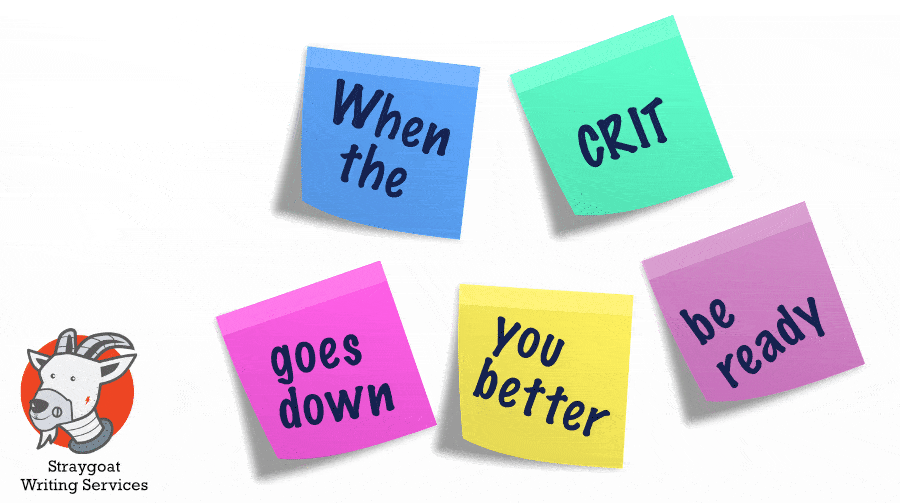
What happens in a Content Design crit(ique)? I wasn't entirely sure, but recently, I completed Content Design London's training course and got to experience a crit for myself. Here's my thoughts on what crits have to offer.
Let's get started with a quick explanation of what a crit is.
What is a crit?
A crit is a group review of your content. Yep, you're going to put your work up there in front of everyone, all at once. The other people in the crit are likely to include other content designers, subject matter experts and possibly other interested parties. Yikes!

Are you thinking "Uh-oh, that sounds a bit daunting."? I think that's pretty normal. I spoke to some of the other people on the course and they were a bit hesitant too. But the crit isn't about judging anyone, it's purely for making the content as good as it can be, in a constructive way.
The goal is to make the content clear, accurate, engaging and as accessible.
Why not just have regular reviews?
When I first heard about crits, that was my first thought. On all of the technical writing projects I've worked on, the usual process is to write a draft and get it reviewed. This always involves the SME and may involve a peer review from other writers, although the peer review hasn't been as common in my experience. It works well enough and is good for checking the accuracy of content, but it has some flaws too:
If your work is only reviewed by one person, you're getting less input. They might be having an off day or are too busy to give the review their full attention.
If the person reviewing your content is too worried about hurting your feelings, they may hold back.
If there is a personality clash, it can be a problem with one-to-one reviews.
From what I saw, I think a crit could help avoid these problems.
What I liked about the crit
On the Content Design course, two pieces of work were volunteered for the crit. They were put up on the projector and as a group, we discussed what worked and what could be changed, from headings and forms to the phrasing of the content.
It was all very constructive and there were mixed views on some parts, but it felt like a brainstorming session. It was definitely not a "tear it to bits" session!
What I thought worked really well:
Variety of perspectives.A few of the people on the course were user researchers. They seemed to be the ones who were quick to spot when information could be visual rather than text. Having that input is really valuable if you are predisposed to textual content, as many of us writers are.
Increased chance of spotting missing info.You've more chance of a group of people spotting gaps in the user story. We'd already had some pair writing sessions, so both of the pieces in the crit had already been read by at least three people. Even so, in the final crit, unanswered questions were spotted for both pieces.
Collaboration = more ideas.In both crits, one person in the group made a suggestion and that sparked ideas in other people. You don't get that with a one-on-one review.
Just suggestions, not a mauling.The comments made were just suggestions or questions that will help the content designer to fill in any gaps. Everything was constructive. The only scoffing was at lunch time.
So some definite advantages over the one-on-one reviews I'm used to. Unexpected advantages too. I have to admit, I was sceptical about crits beforehand.
But putting my "what if?" Mr Negative hat back on for a moment, there are some issues I can imagine might affect a crit. I'll look at those next.
Things that might limit the success of a crit
One thing that really struck me was how open-minded and sharing everyone was. Nobody struck me as being particularly domineering, pig-headed or timid, so the crit worked well. But in the real world, what happens if you have a rampant ego, a dominant alpha, or a timid wallflower involved?
Is the dominant alpha going to use his/her forceful personality to steer the content to how they want it to be?
Is the timid writer going to be too intimidated to share their great ideas in a group scenario?
Will someone with an ego take the crit personally and change the dynamic?
I asked our trainer, Hinrich von Haaren, about this and he said that it is important that the crit has a "master". It's the master's job to keep the crit on track and to steer it away from negative criticism and encourage engagement.
Hinrich also suggested that when you have dominant personalities or shy people in a group, it can help to ask people to make comments on post-its at first. That way, everyone can get their ideas noticed. I really liked that idea and wish I'd thought of it in the past, when peer-reviews got a little out of hand due to personality clashes.
In some workplaces, I think the crit master might have their work cut out for them! And I suppose there's always the chance that the crit master doesn't have the management skills to control more forceful personalities.
Over to you
If you're a technical writer or copywriter with an interest in content design, 'd definitely recommend Content Design London's training course and Sarah Richards' book "Content Design". While some of the concepts and ideas will be familiar, there are lots of little bits that can really help you in your work. Even an old dog like me learned some new tricks. And it was really helpful to see how content designers work. I have to admit, I feel drawn to that kind of work, so hope to get a chance someday. It'll be a rest from tech content if nothing else!
If you're a content designer already, maybe there are some things I've overlooked? Perhaps you have real-world experiences of crits that prove I'm talking out of my hat (wouldn't be the first time)? If so, I'd love to hear about them.

